You may not find this terribly rewarding unless you're included here, so this is a good time for casual and random browsers to turn back before they get too caught up in the sweep and majesty of the proceedings and can't let go.
A quick ride on the Leonardo local into Rome Termini, then an hour's ride south at 300km per hour on the Frecciarossa high-speed train to Napoli Centrale, and a taxi ride over to the Castel dell'Ovo

The Castel dell'Ovo is perched on a little island just off the port area of downtown Naples, in the neighborhood of St Lucia, named for the tiny Basilica of St Lucia a Mare nearby. It's the older of two serious castles along the port area, and it's teamed on the island with the venerable fishermen's quarter, the Borgo Marinari, presently populated by about eleven restaurants and, now, us.
The point of this photo was to get Kristin in front of the Castle dell'Ovo but, more importantly, with her beloved isle of Capri on the horizon.
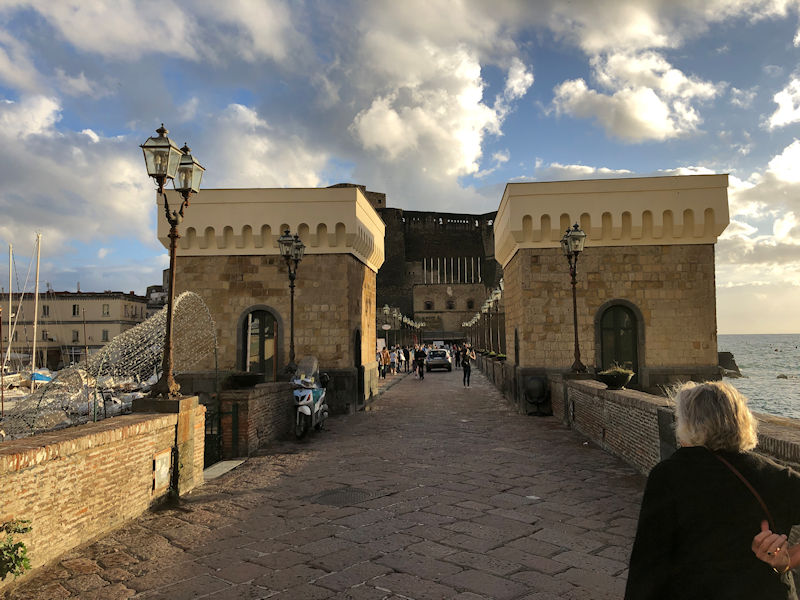
The causeway and bridge to the castle lead both to the restaurants and to a marina for mostly pleasure boats, and to the castle of course.

The castle itself is, however, off limits now for renovations -- the last time we were here, we could walk round some of the interior passages, though not much more than that as a lot of it is occupied by working administrative offices.
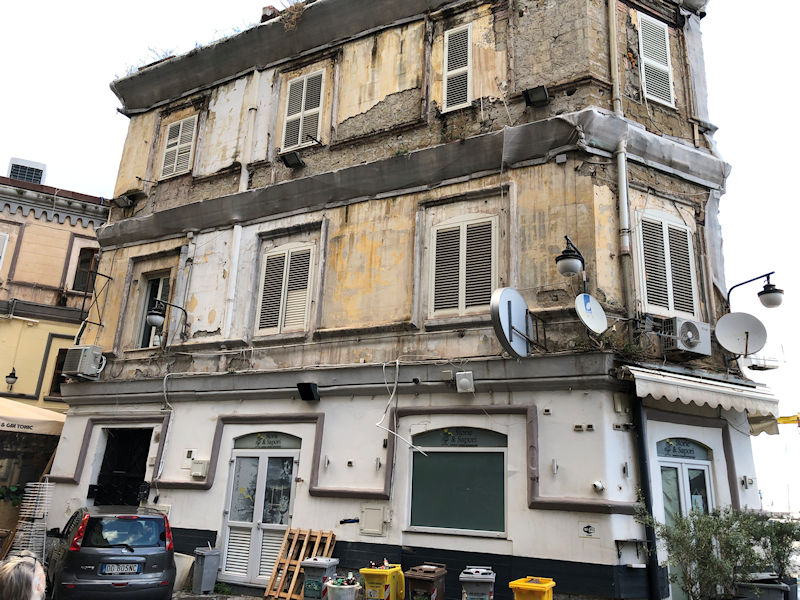
And here, at the end of the occupied island (except for the Powerboat Italia refueling area), is our new accommodations for the next week. (The restaurant Storie & Sapori on the ground floor is either closed for the season or closed forever.)
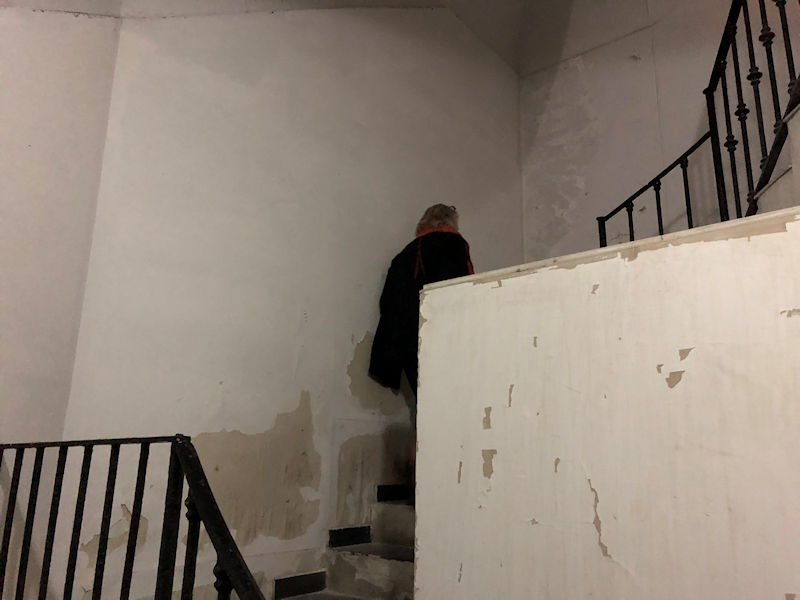
Up we go
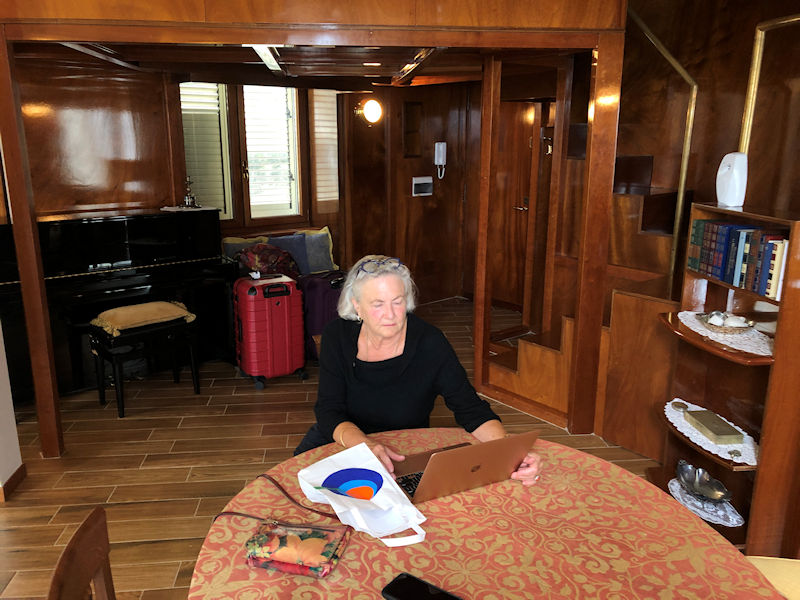
Surprise. The landlord described our flat as a kind of yacht's interior jimmied in among the exterior desolation, and noted that paperwork is ongoing for their plans for a thorough renovation of the lot of it.

In the meantime, unless it all falls in, this is extremely nice.
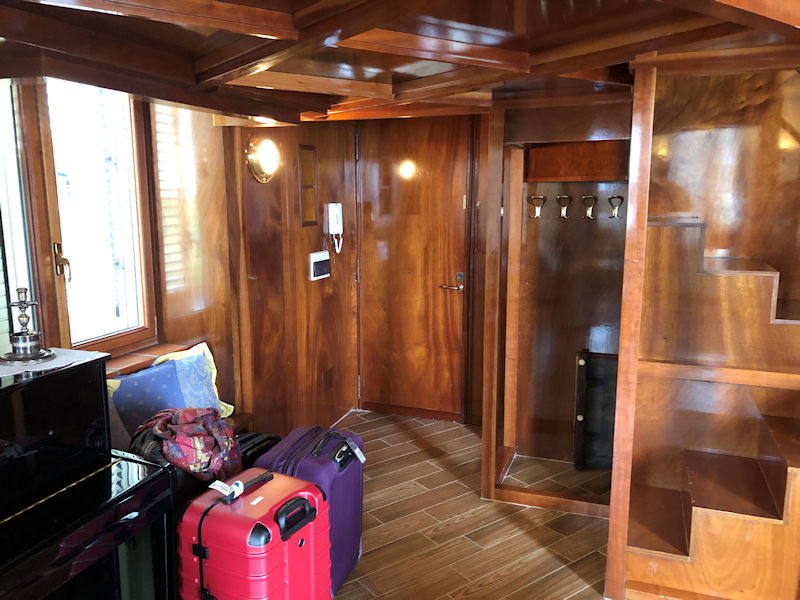
The stairs up to the bedroom and bathrooms are a bit of a problem -- steep, with precious little to hang onto in the middle of the night . . . but where there's a will, there's a way (despite a few moments of terror).
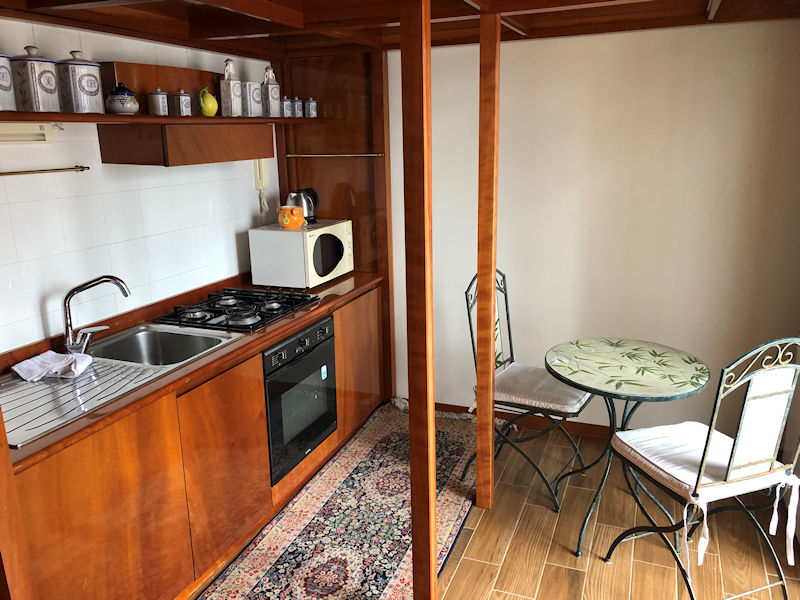
A usable kitchen, though a few of the appliances seemed not to be working, but in a neighborhood of amazing Italian restaurants we weren't planning on doing very much dining in, or any at all in fact.
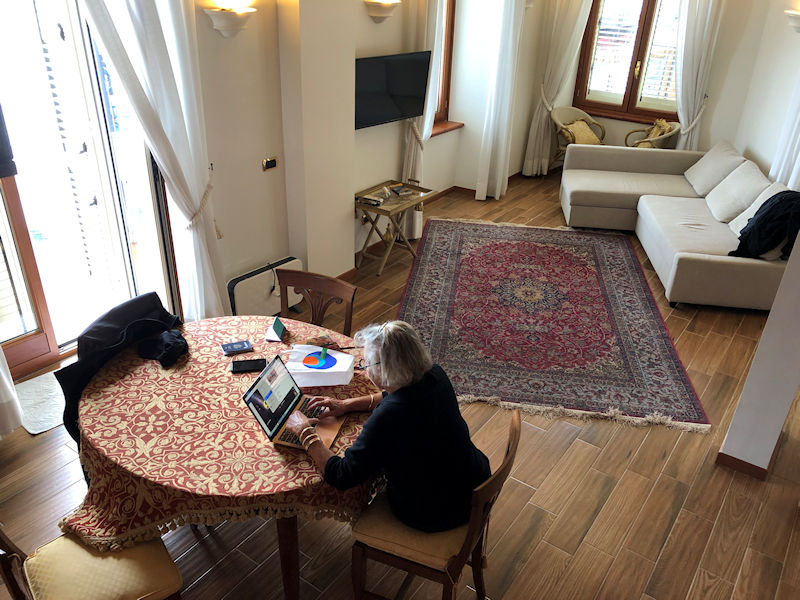
The view from the dubious stairways
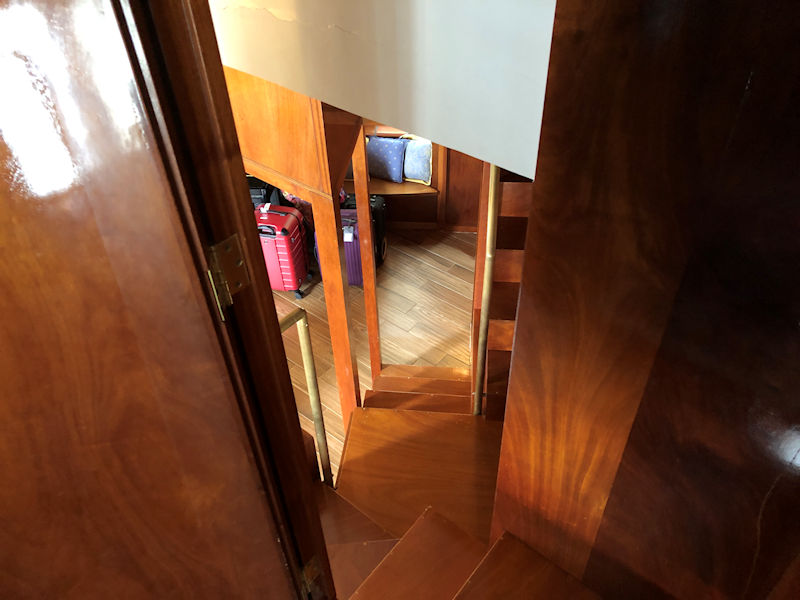
The view of the dubious stairways
[-- Hang on! -- To what?]
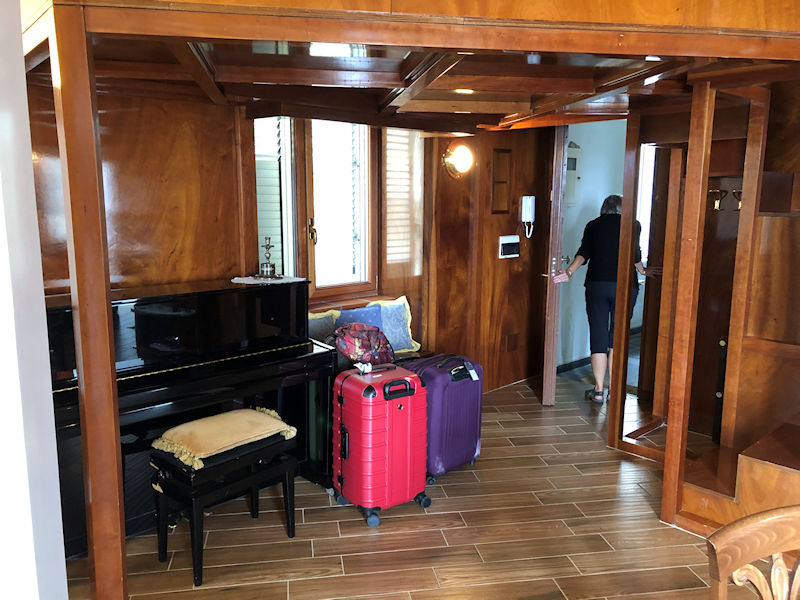
There was nobody in our immediate party who thought to test if that piano was working and in tune.
But our friends Oscar and Cathy joined us a few days later and Oscar had a go at it with a few simple tunes, though we still couldn't determine whether it was in tune or not.
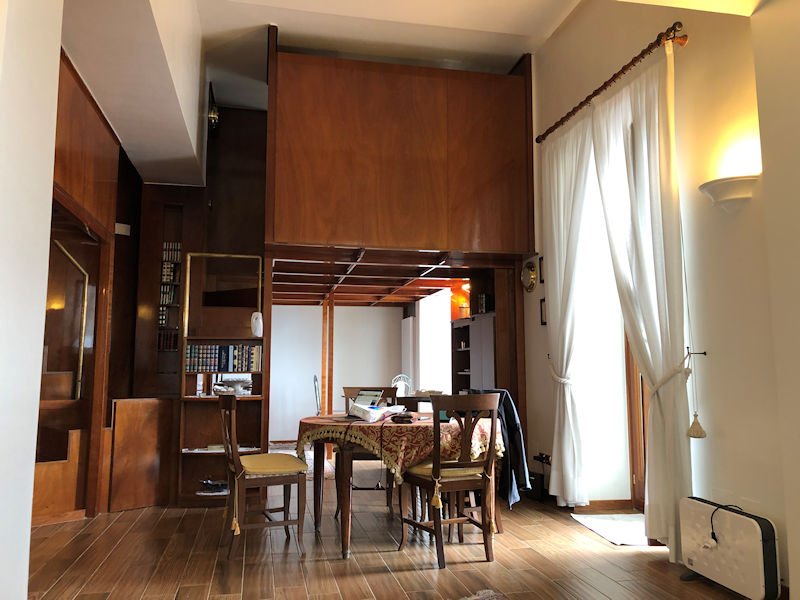
The kitchen area, with a kind of low ceiling on it (which is actually the bedroom, firmly anchored to something, presumably)
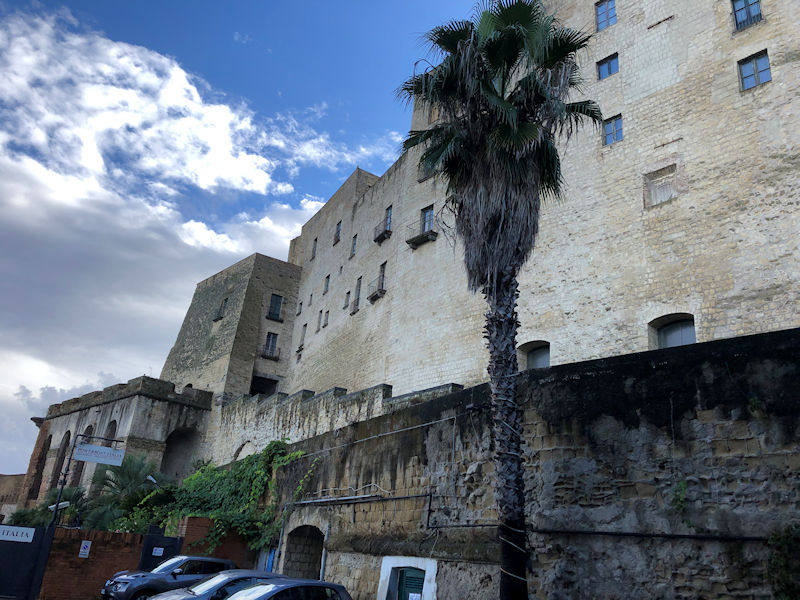
The view out the window on the piano side -- lots and lots of Castel dell'Ovo.
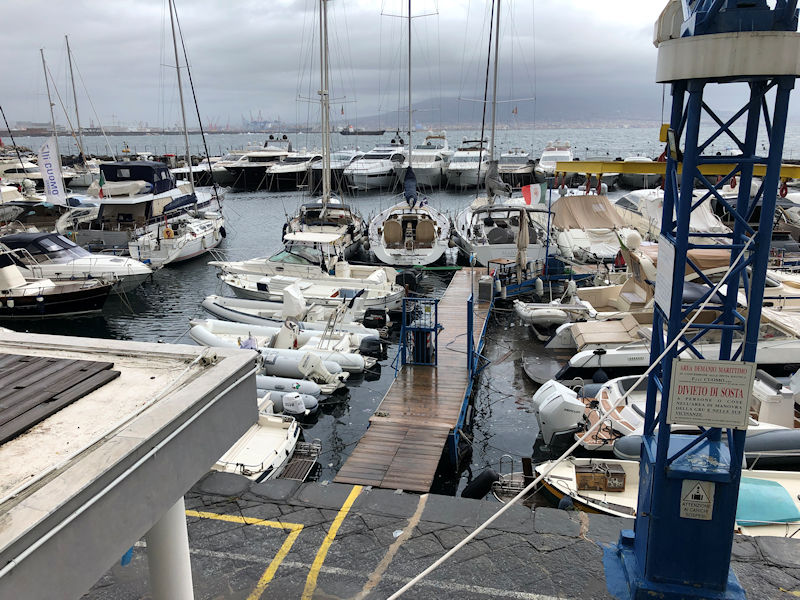
And from the balcony side, the marina and the Bay of Naples behind, Mt Vesuvius enshrouded
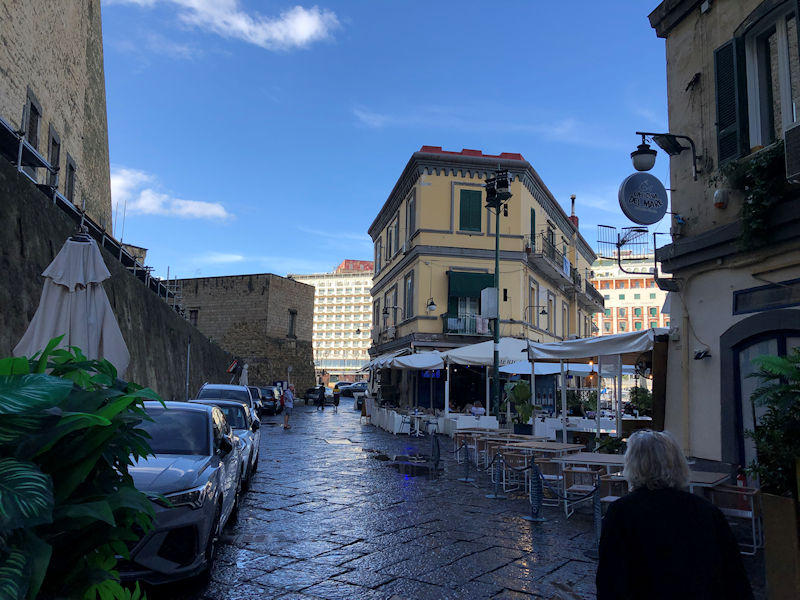
We're going out for a getting acquainted lookround, a 'scoping mission' -- castle all along on the left, the Trattoria Castel dell'Ovo ahead.
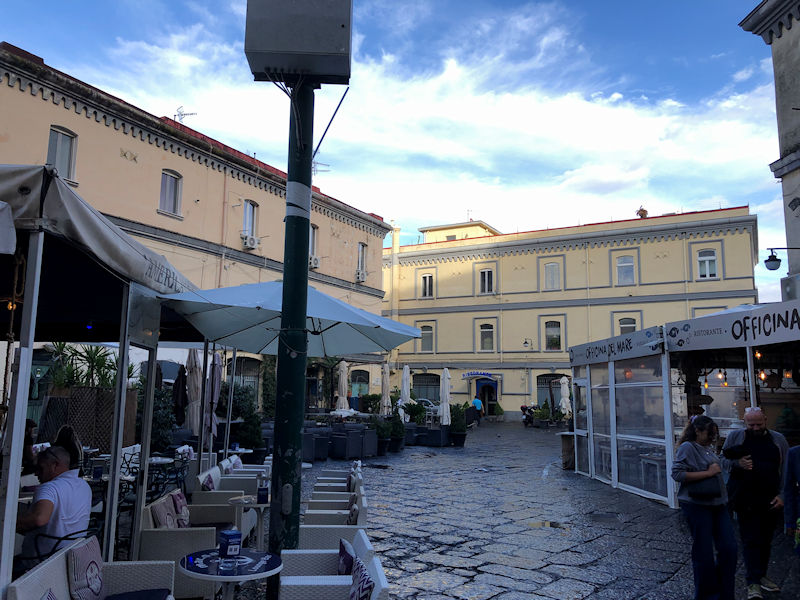
Four more restaurants just in this photo
We had a bad experience on our first night in the one on the right, when the martinet maitre d' tried to move a wobbly and defective gas heater, flaming up nicely, on a pole directly over Kristin's head and was disparaging when she protested emphatically. We didn't go back.

-- Hang tight, old castle; we'll be back soon.
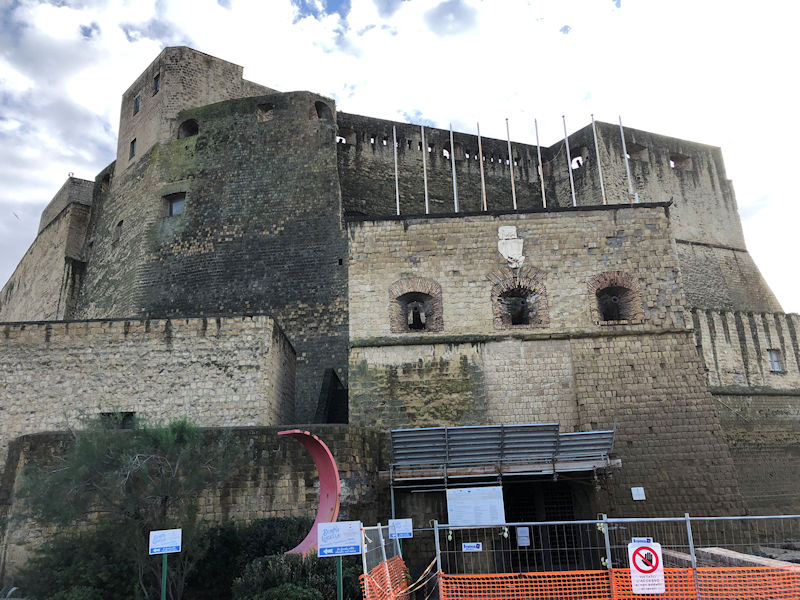
Since the Normans, Hohenstaufen Swabians, Angevin French, and Aragonese occupied these Neapolitan fortresses for so many years (Castels dell'Ovo, Nuovo, and St Elmo), we can understand why they have as many cannon pointed into the city as out to sea.
(A fourth urban castle, the Castel Capuan, was much transformed for administrative purposes early on.)
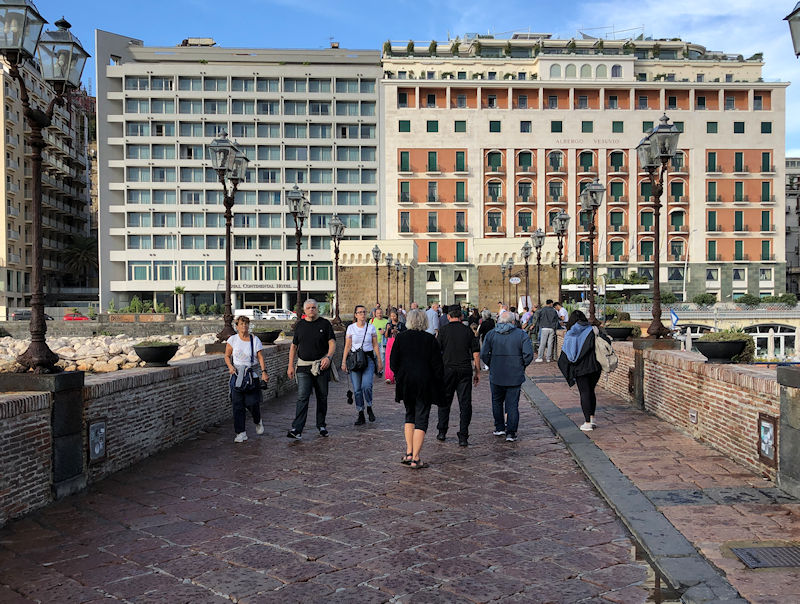
Back to the mainland, on the Passaggio Castel dell'Ovo, for a short walk round
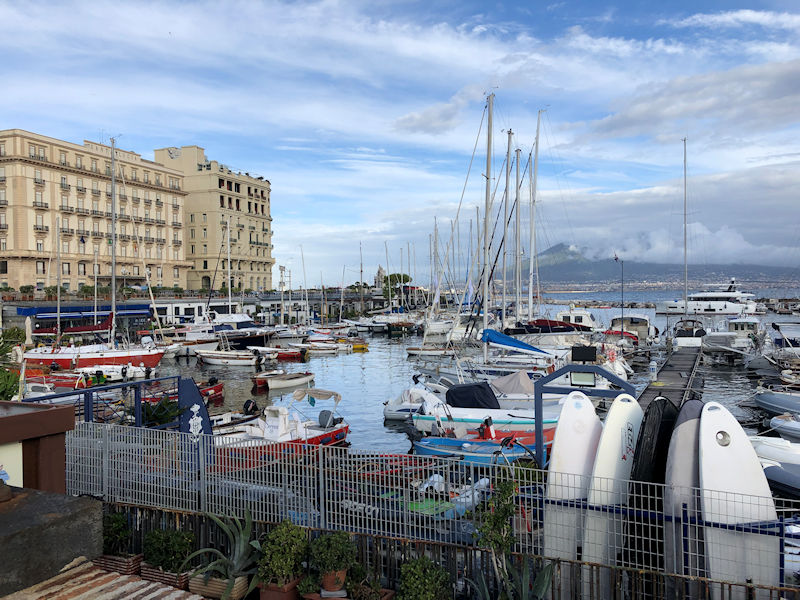
Marina on this side, too

A caption from our earlier visit: The Castel dell'Ovo, very old -- it's been built over a Roman villa on the little island, which was transformed in the 400s into a monastery, and then in the 9th century into a great whacking castle. Its present form dates from 1503 in the repairs made after a brutal siege by Ferdinand II of Aragon (the fellow who sent Columbus to find America, created the Spanish Inquisition to destroy Islam and Judaism in Spain, and crushed Naples soon after).
At our last visit, there was an art party going on along the roof, but we'd missed the free drinks.

Hotel Row along the one-way Via Partenope, and . . .
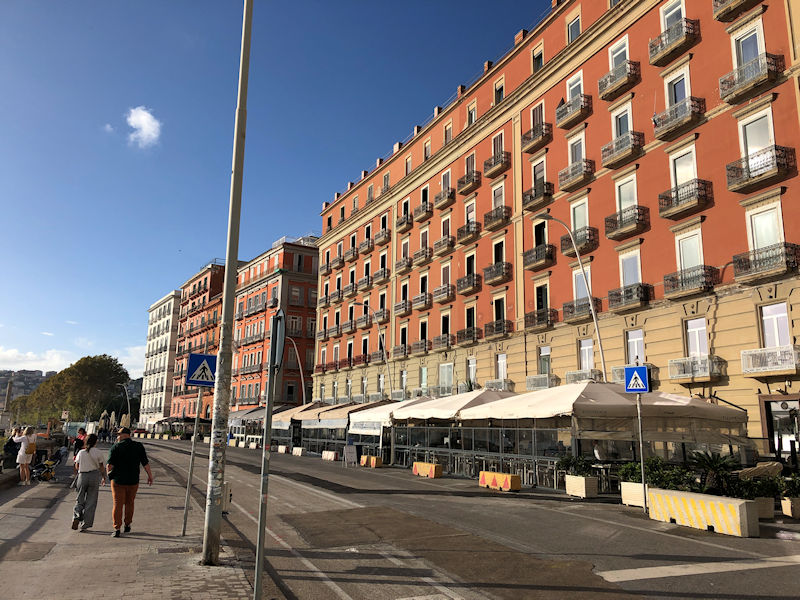
. . . it's at one of these grand monstrosities that our friends will be camping when they arrive in a few days' time.
(Parthenope, the early name of the city, was founded by Cumae, the earliest Greek city on mainland Italy, at the end of the 8th century BC. She was a siren of Greek mythology, said to have thrown herself into the sea when she'd failed to bewitch Odysseus with her songs.)
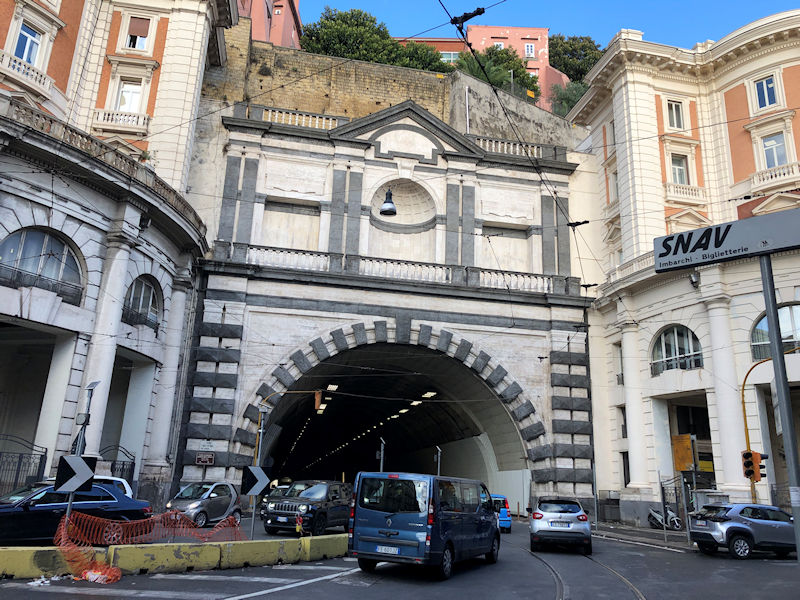
A few blocks in behind the seaside parade of hotels, this is the Tunnel della Vittoria, which is apparently the only way to get by car into this part of the city from the main port -- the shoreside Via Partenope is one-way the other way.
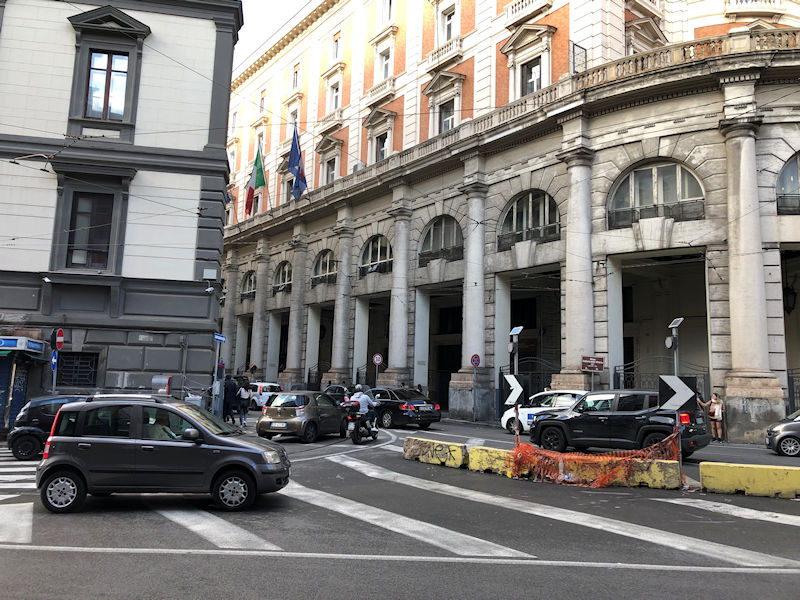
The neighborhood near the tunnel
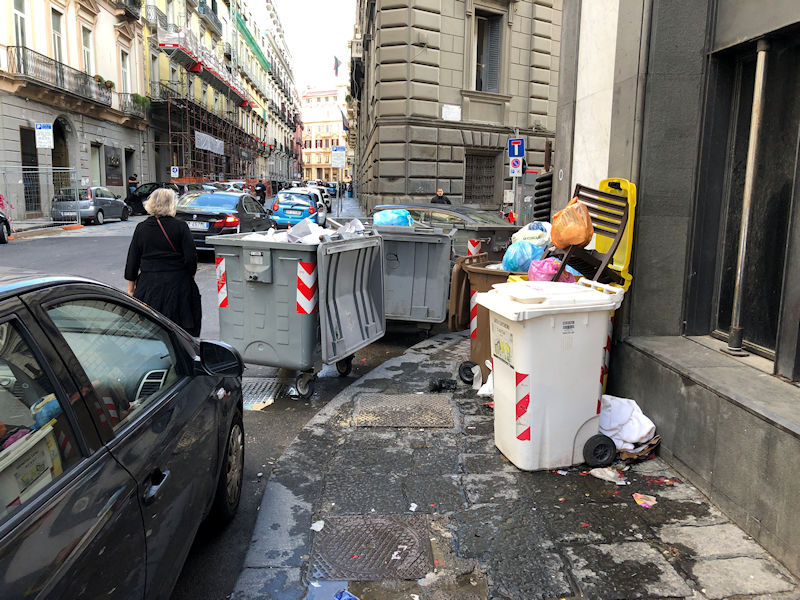
The last time we were here (as I recall) uncollected trash was a serious problem. This looks nearly as bad, but we didn't see anything like this elsewhere round the city this time.
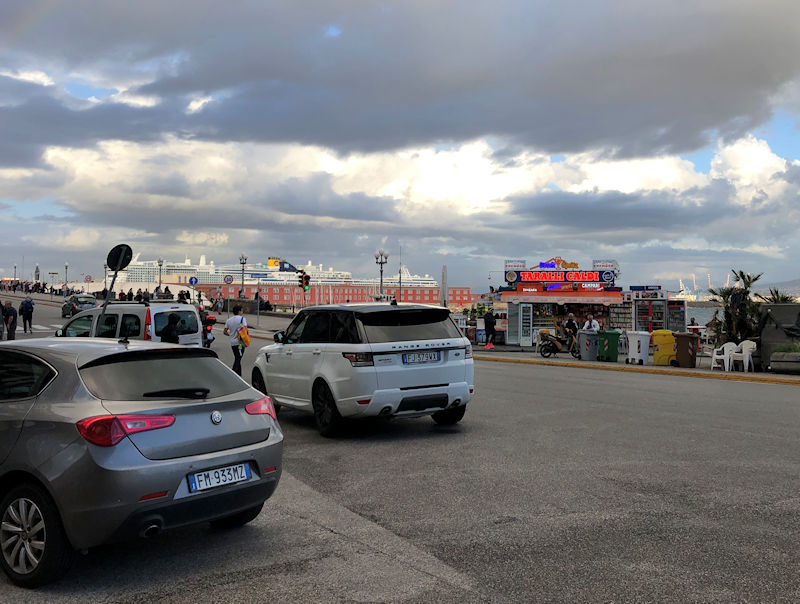
Back out to the Via Partenope, with a huge cavalcade of Mega Cruise Ships lined up on the port.
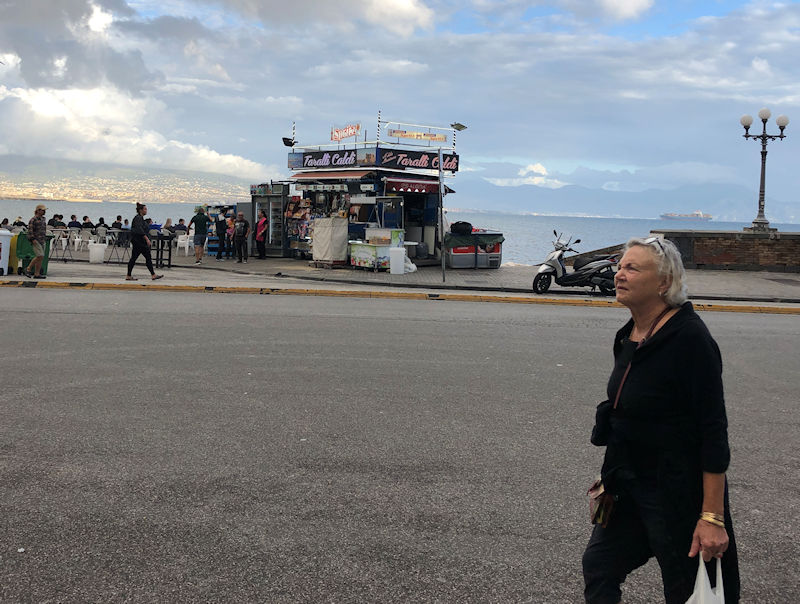
-- Good lord, what's that?!?
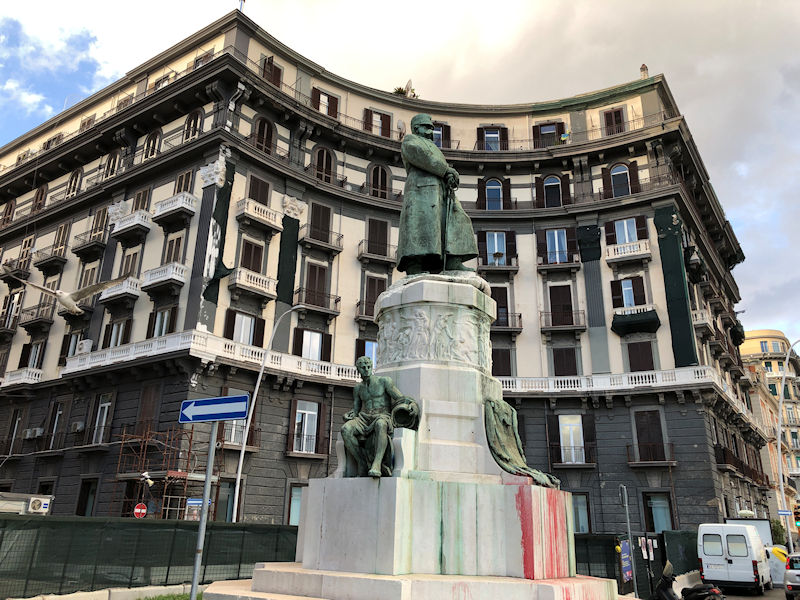
It's a walrus in an unflattering coat. Or, as the plaque specifies, it's Umberto I, King of Italy from 1878 to his assassination in 1900 by an Italian-American anarchist. Gazing out to sea, wistfully.
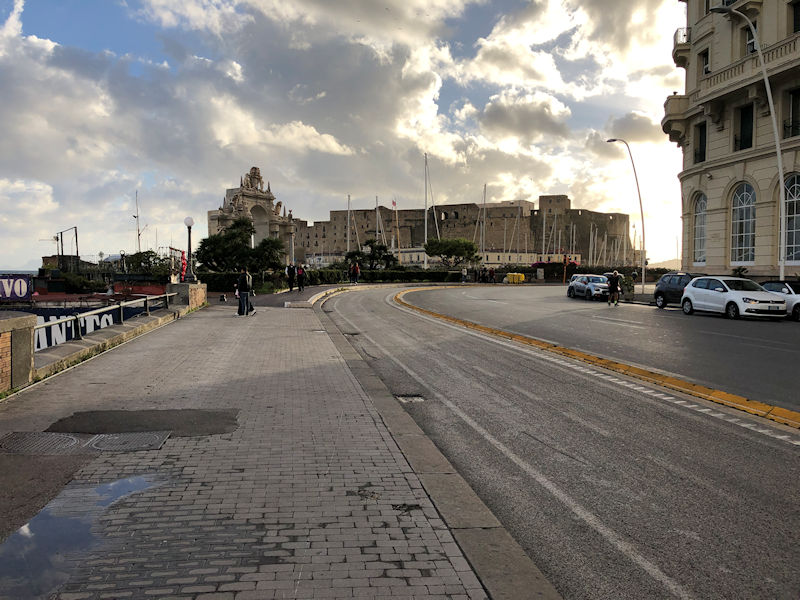
The Castel dell'Ovo from the shoreside Via Partenope, with . . .
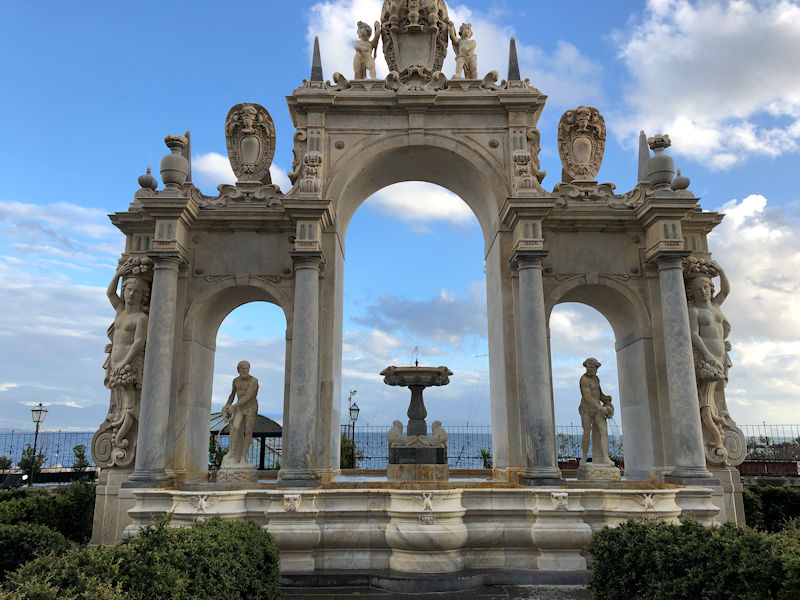
. . . the Mannerist so-called Fontana del Gigante, created in the very early 1600s for the Spanish Viceroy of Naples by Michelangelo Naccherino and Piero Bernini (Gian Lorenzo's dad, who also made the Fontana della Barcaccia in the piazza of Rome's Spanish Steps). It was placed next to the Royal Palace in what is now called the Piazza del Plebiscito, and it was joined by an enormous statue alongside after a colossal bust, thought to be of Jupitor Stator, was found in Cumae in 1670 and fitted out with other bits and bobs and erected in the square, thus the fountain's present name (the bust is now in the Naples archaeological museum). The fountain was disassembled and removed in 1815 and left in storage until 1882, then reassembled in several unsatisfactory places, but eventually in 1905-1906 to this elegant position near the sea.
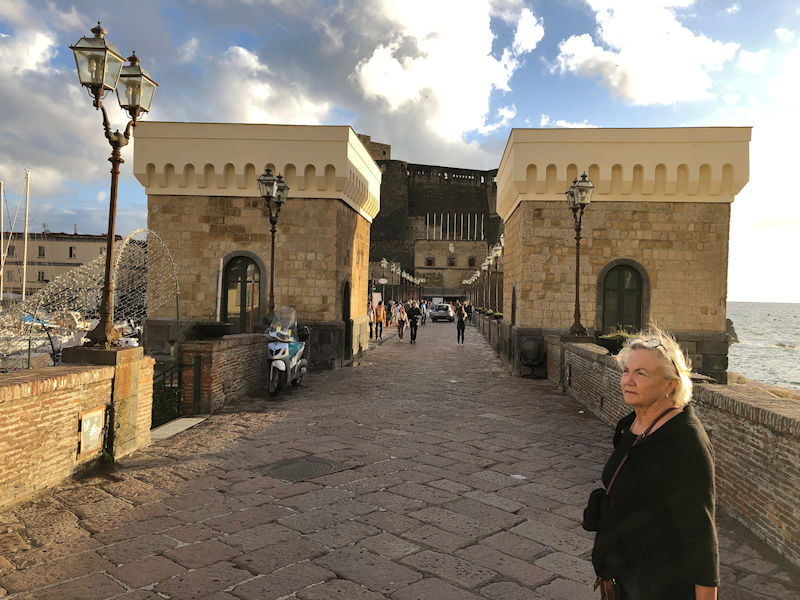
Back from our introductory walk
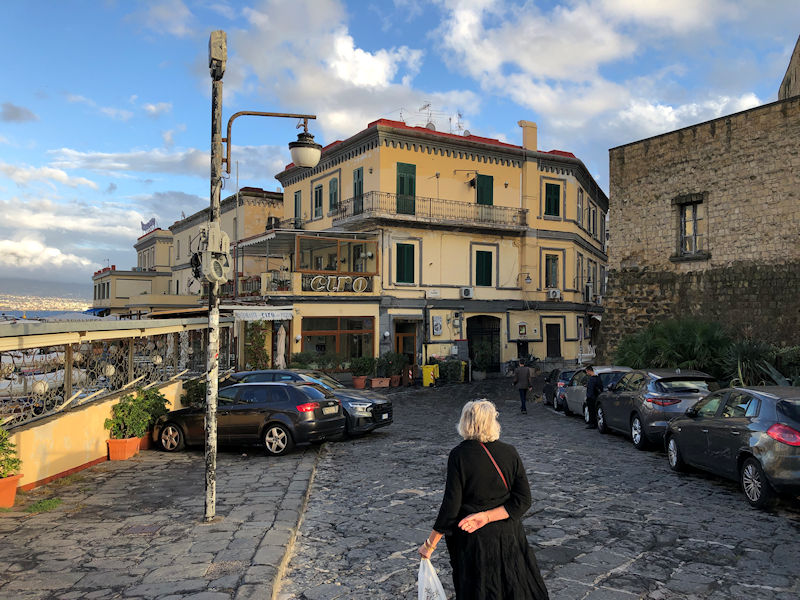
The Ristorante Ciro just ahead has been recommended, but tonight we'll try the Officina del Mare and see if we can get a flaming floor heater dropped on our heads. Tomorrow night: Ciro.
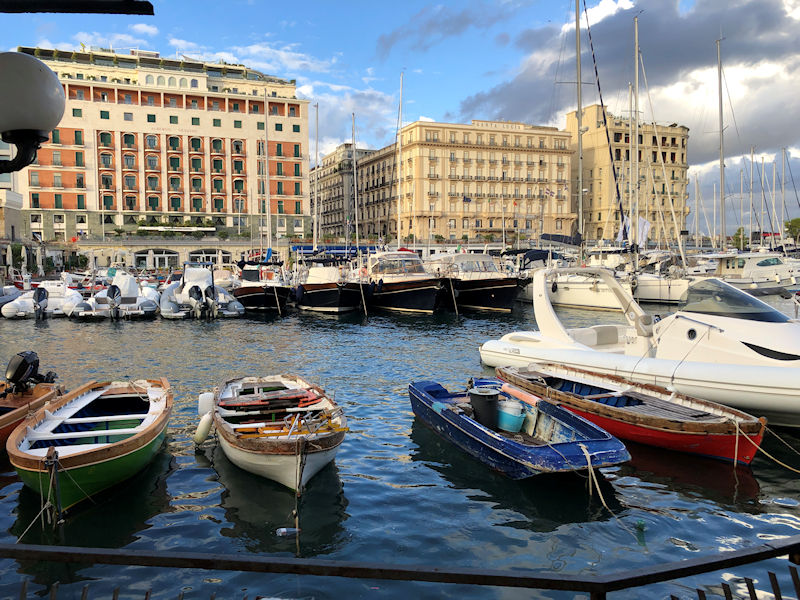
The marina facing Hotel Row
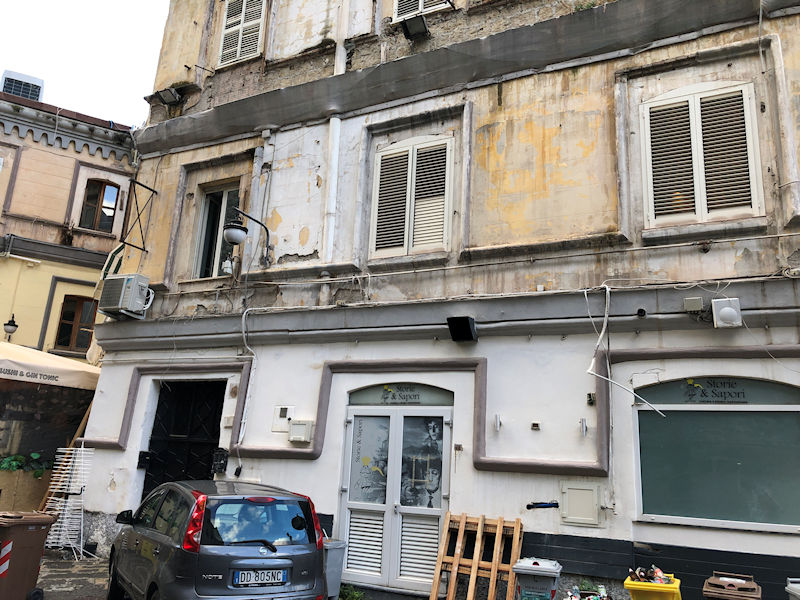
Great news, the building's still standing.
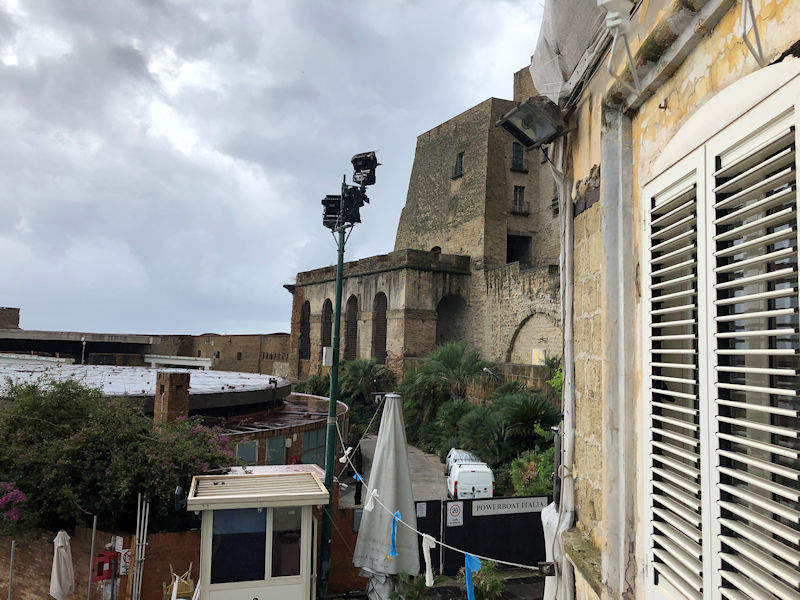
The Powerboat Italia facilities, whatever they are. Fuel, for one thing, but what else? We did see them winching a few boats out of the water a few days later. A full service operation.
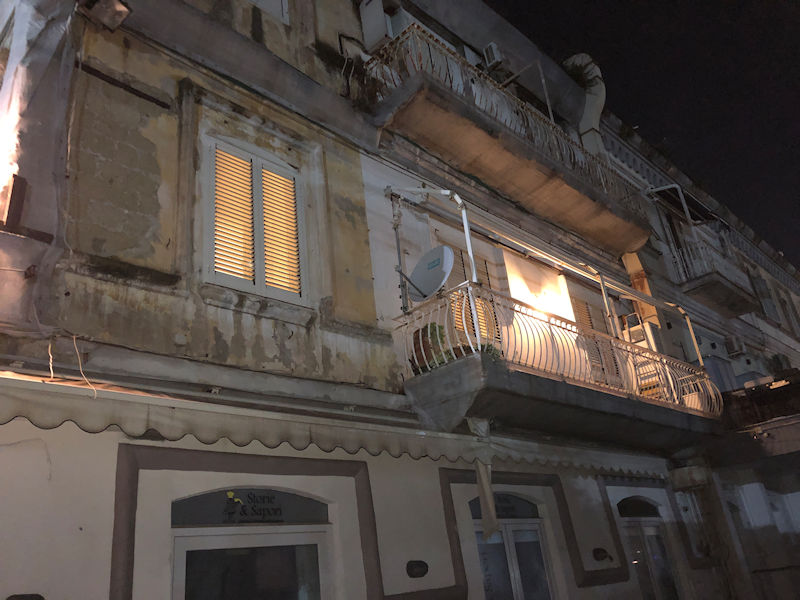
Coming home from dinner -- we'd left our lights on, oh well (not our electrics bill).
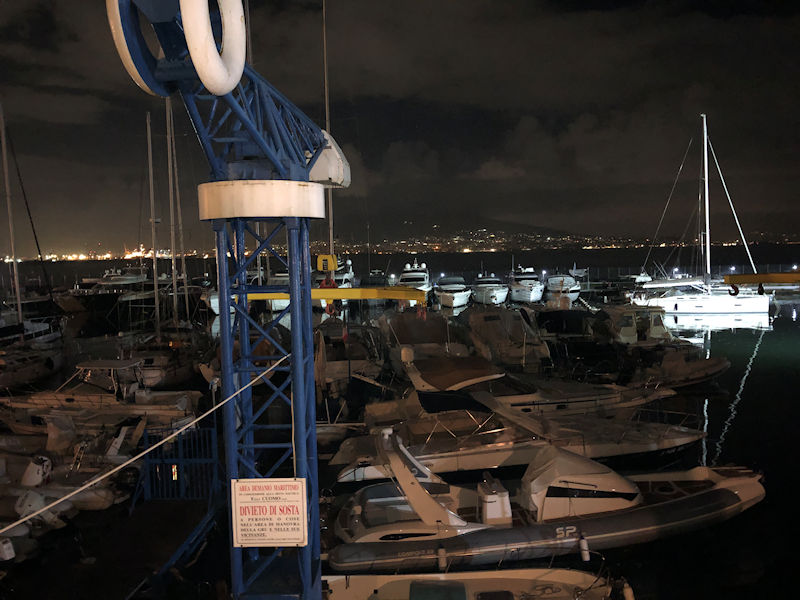
The marina at night

And the view farther along the port area
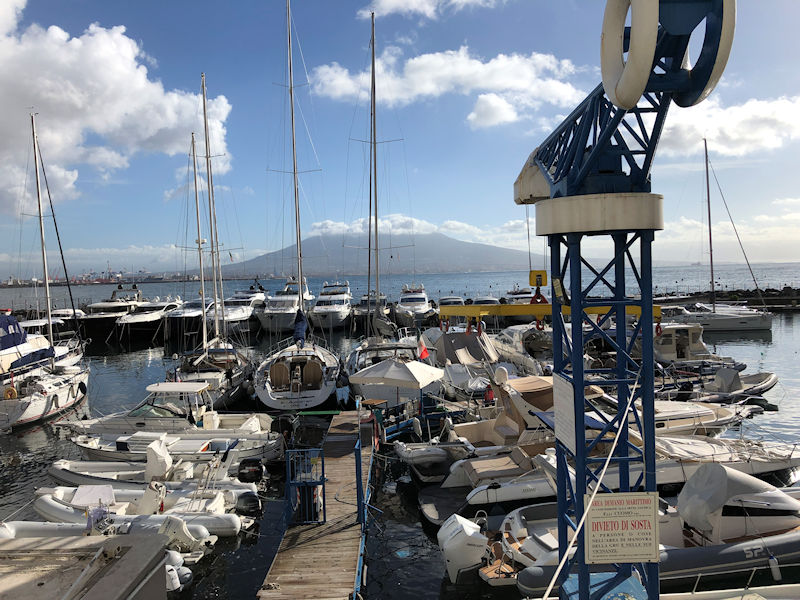
Bright and early the next day, 26 October 2023 -- well, bright the next day, anyway -- we're off on some errands.
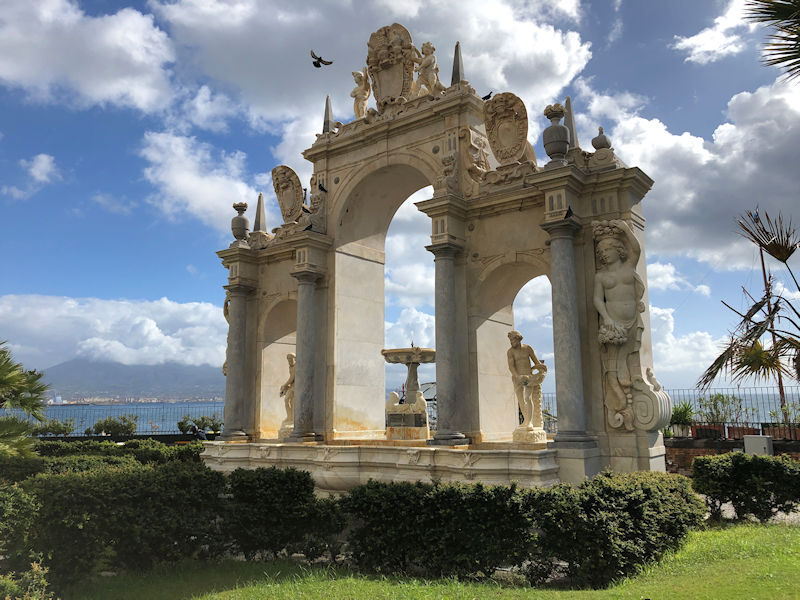
The Fontana del Gigante
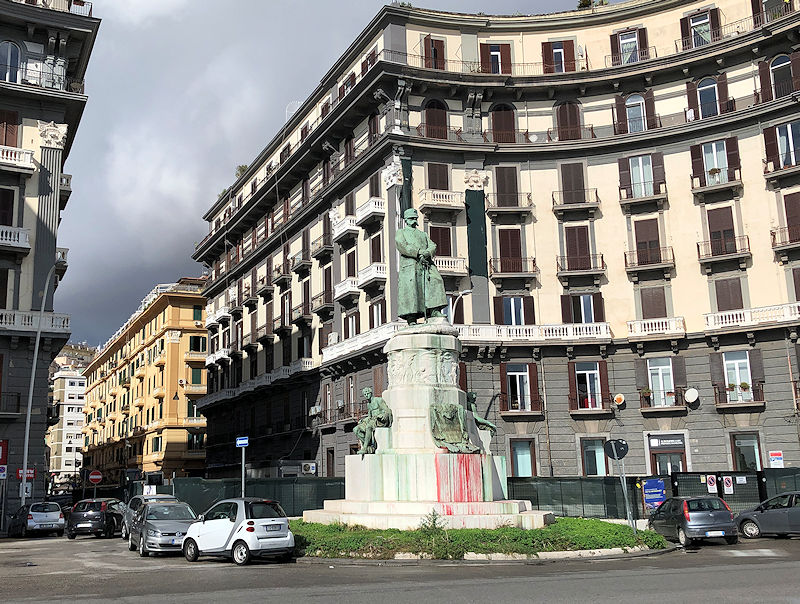
King Umberto I in a very austere moment, and . . .
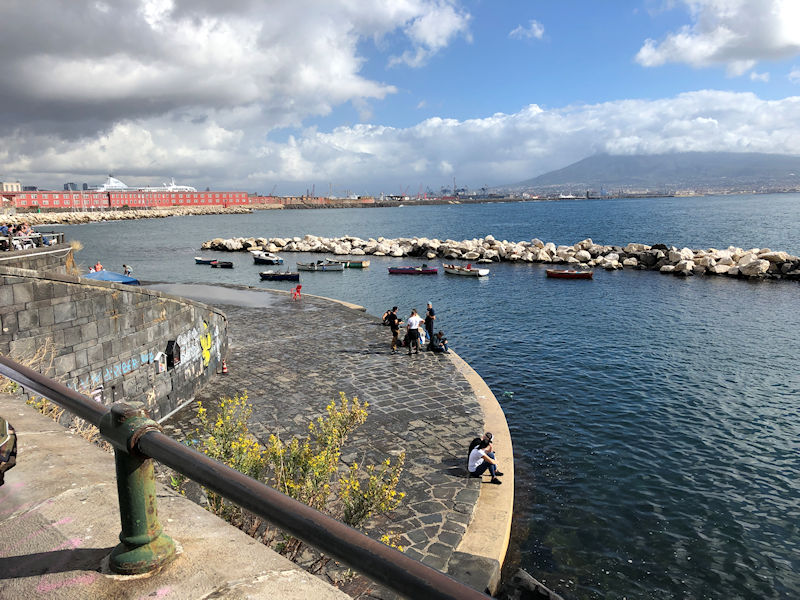
. . . just in front of him, the Rotonda di Via Nazario Sauro (the Via Partenope changed its name round the curve by the Fontana, to Via Nazario Sauro). Swimming may or may not be possible, but we did see families who'd hired little coastal tours in those anchored boats being helped out of them after their pleasant ride.
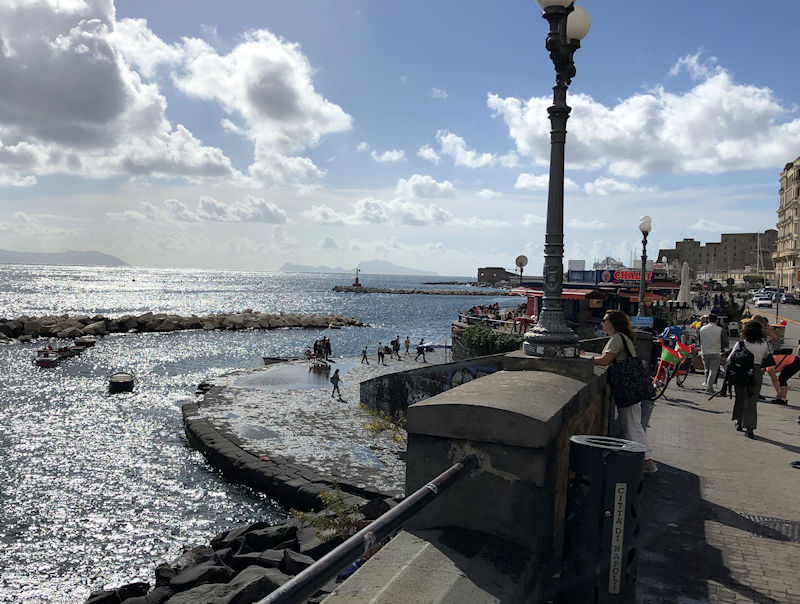
Looking back at the Rotonda, and that's Capri on the horizon. Capri was a high-ranking desideratum on our party's planning lists, long nostalgic memories of Capri for one of our members and good impressions for the other one -- neither had ever climbed the ancient path up the great bulge on the right side to the part called Anacapri. Time overtook us though, and it was not to be, on this trip anyway.

Approaching the serious port area, with the Castel Nuovo in the offing
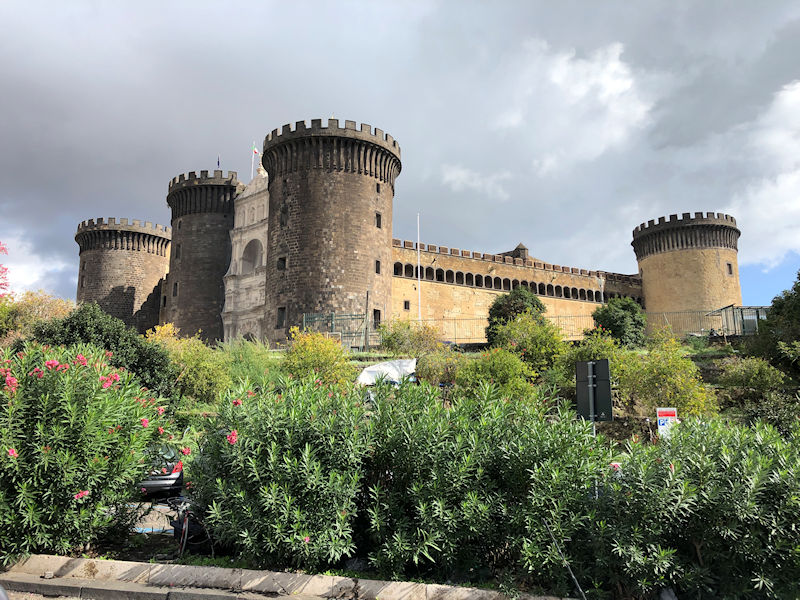
As we're coming up from the sea-level port area, with some splendid parks and small amusement rides for the kiddies, there's the Castel Nuovo.
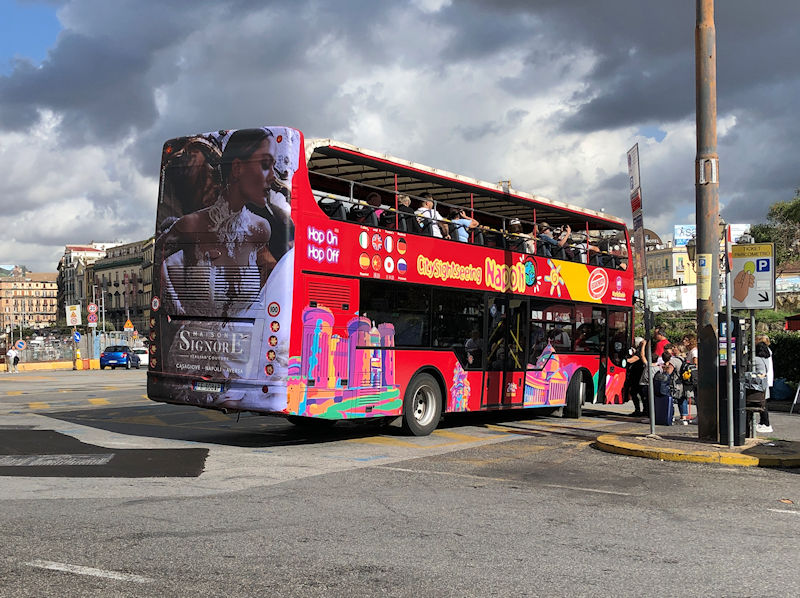
Here's a 'Hop On, Hop Off' bus. Shall we? Erm, nah, I don't think so.
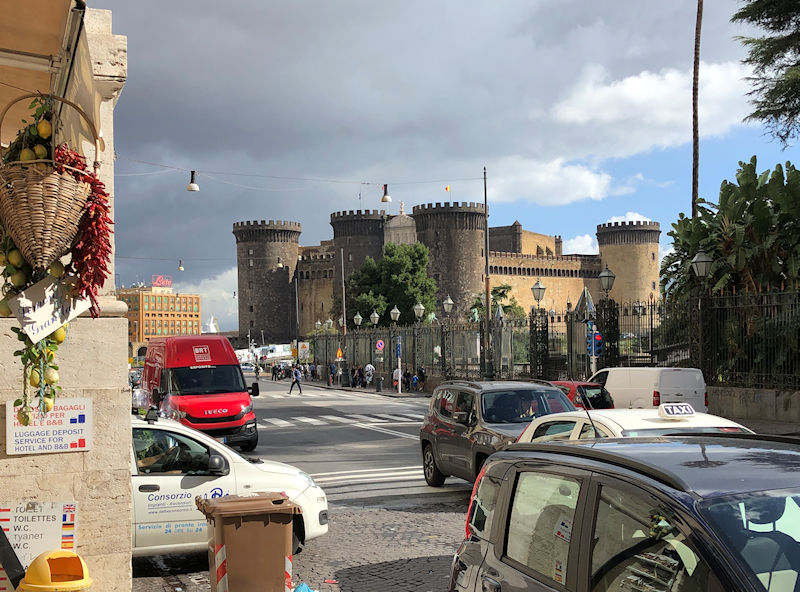
Five big towers and lots of big halls and apartments -- the French Angevins brought with them huge numbers of hangers-on and the Castel dell'Ovo got to be too small. So this was got underway in 1279, but it was the Aragonese Alfonso who got it into this form in 1443 -- that's
Alfonso V the Magnanimous, King of Aragon and King of Sicily, who in 1442 drove the Angevin French regime out of here after decades of trying and became, also, Alfonso I of Naples.

Nearby, that's the Teatro San Carlo, opened in 1737 and still going.
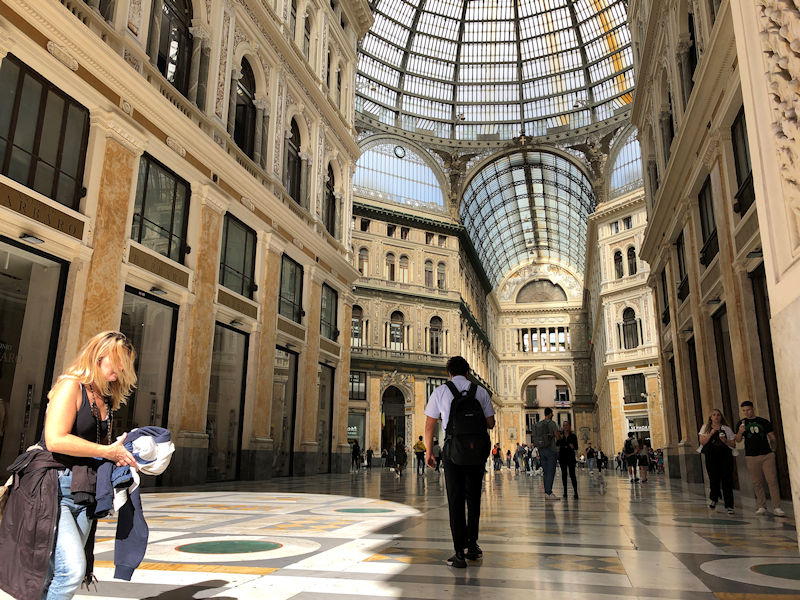
And one of the first dedicated malls anywhere, and still the classiest, the Galleria Umberto I, built 1887 to 1890 and the centrepiece of the massive rebuilding of Naples project (the Risanamento, 'making healthy again') that carried on up to the Great War.

A few steps over, here's the Piazza Trieste e Trento, the hub of the major avenues of Via Toledo, Via Chiaia, and Via San Carlo, and leading into the Piazza del Plebiscito. The centrepiece is the Fountain of the Artichoke (carciofo) from the 1950s.
The name 'Trieste and Trent' was bestowed in honor of a few Italian victories in the appalling World War I battles in the Alto Adige and Friuli regions north of Venice.
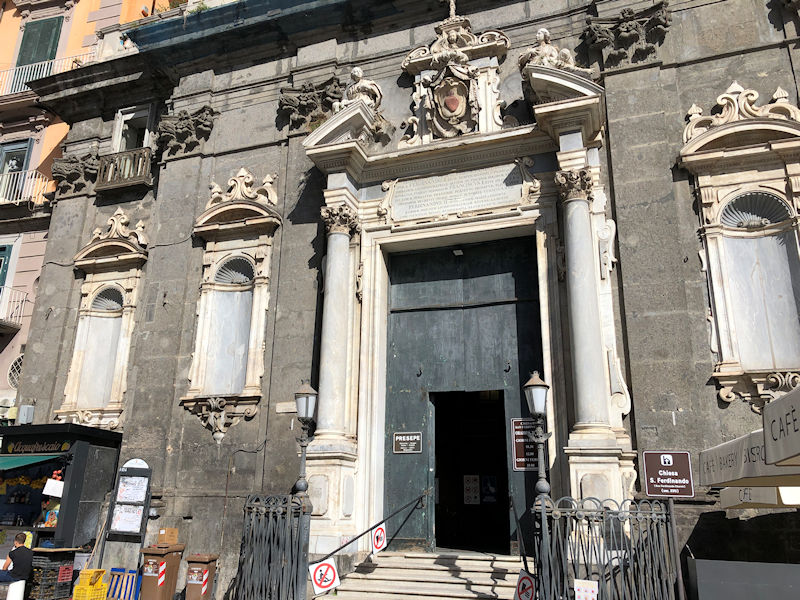
This is the Chiesa di San Ferdinando, facing onto the same piazza, first built by the Jesuits & dedicated to St Francis Xavier, completed by 1616, then amended several times through the 17th century in conformity with Counter-Reformation styles, based on a Latin cross plan with a single nave with side chapels.
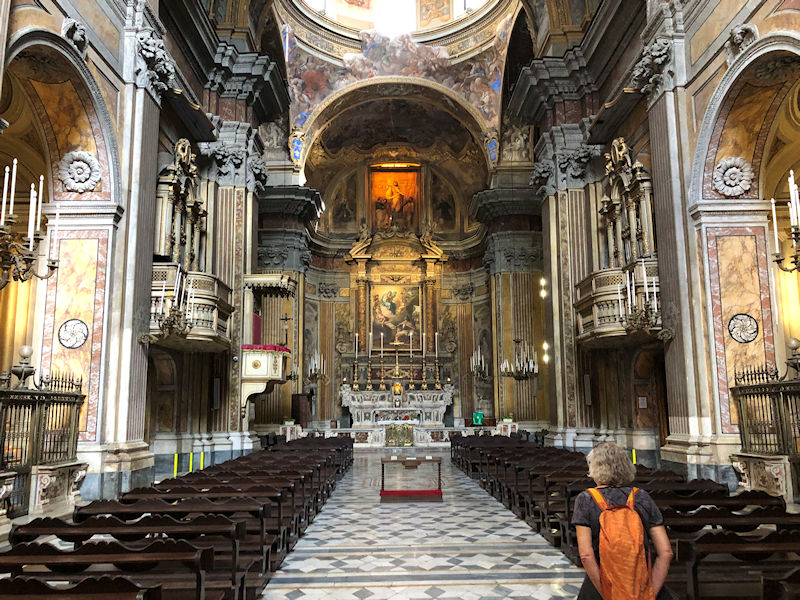
When the Jesuits were expelled from the Kingdom of Naples in 1767, their church was passed on to the 'Sacred Military Constantinian Order of Saint George', who dedicated it to St Ferdinand III, King of Castile and Leon until 1252, canonized in 1671, in honor of the then-King Ferdinand IV Bourbon.
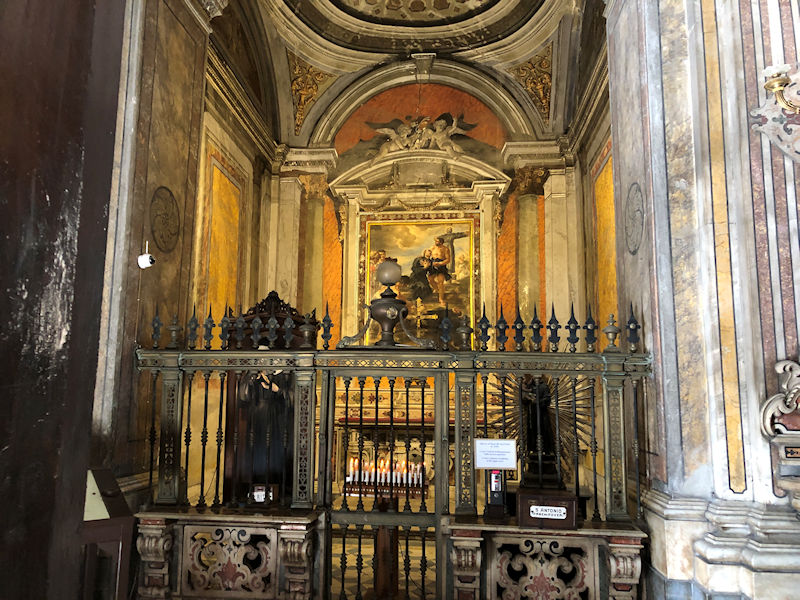
A side chapel
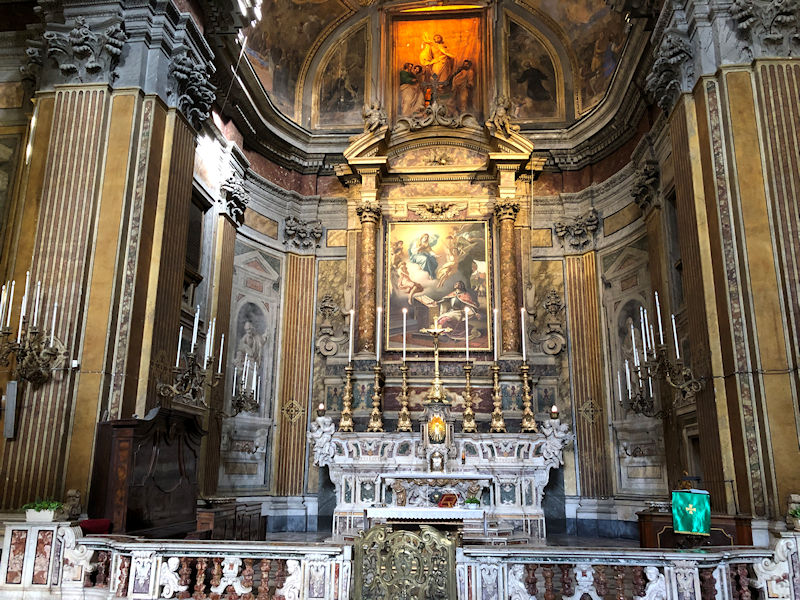
The main altar
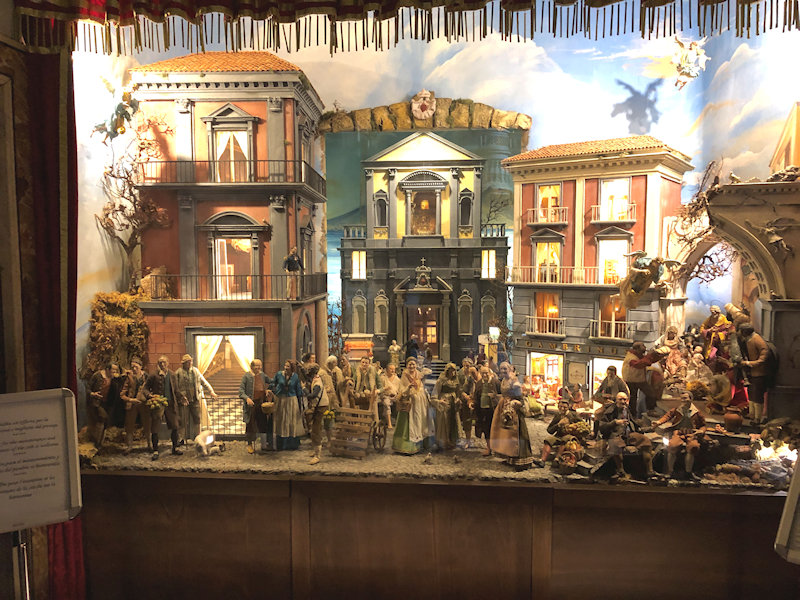
The church also features seasonally a nativity presepe or crèche.
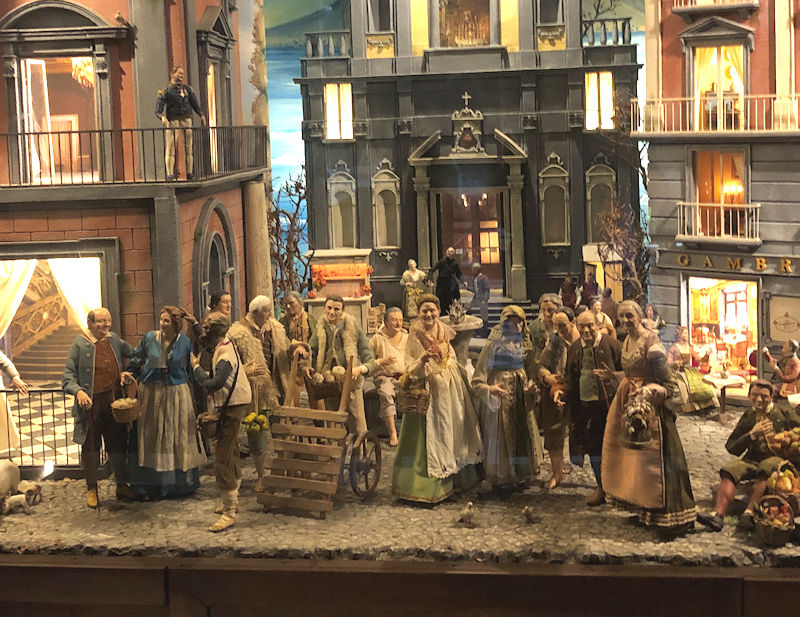
Crèche figures and props (like market vegetables, domestic animals) are a traditional specialized industry in Naples (as our livingroom can demonstrate every December).
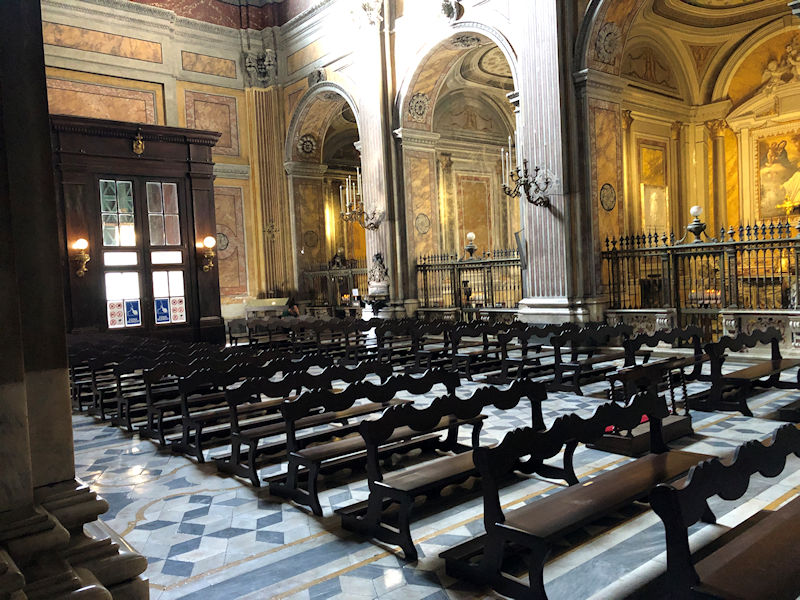
More side chapels

One of our favorite early martyrs, St Lucia, but no artist noted here. Saint Lucy (Santa Lucia) was a martyr-saint, widely venerated from early on, who was said to have been denounced as a Christian by a frustrated suitor and, when she refused to sacrifice in the Emperor's cult, was executed in Syracuse in 304 during the persecutions of Diocletian.
By the 15th century, a gruesome detail had accrued to her story, that prior to her execution her eyes were gouged out (or that she gouged her own eyes out to become less desirable to suitors), and thus she is frequently shown (with her eyes intact) carrying round her eyes on a plate.
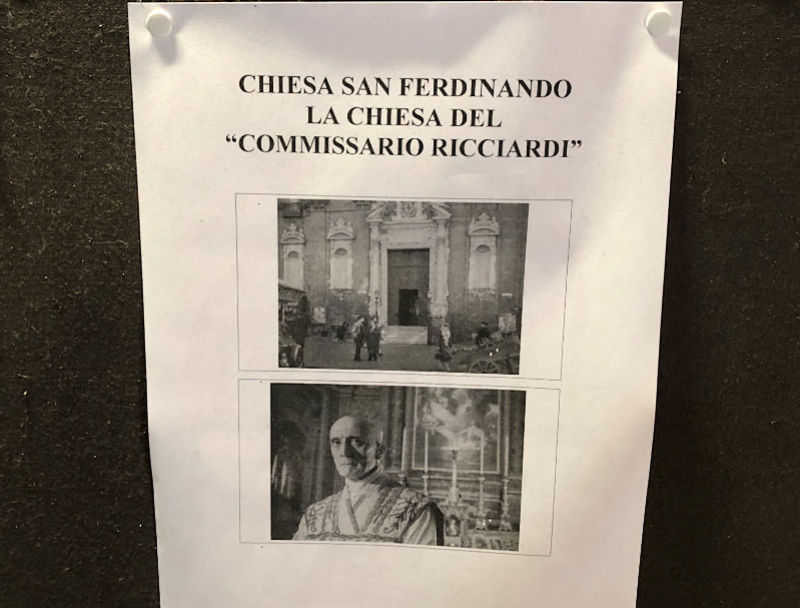
Suitably proud of some new publicity. Maurizio de Giovanni has written (among other things) a series of ten novels featuring a brilliant, shy police inspector in Naples in the 1930s, great settings and historically compelling, especially with the Nazi party administrators poking about everywhere. They were published from 2007 to just recently and translated into English by Antony Shugaar, 2012-2023. They can be weird in their own way but always brilliant. And most recently, in the grand tradition of Sicilian villages proclaiming their use as film sets for the immensely popular Il Commissario Montalbano series (1999-2021, 37 films), Il Commissario Ricciardi has arrived from RAI since 2021, all 10 novels, with subtitles (Imdb 7.8).
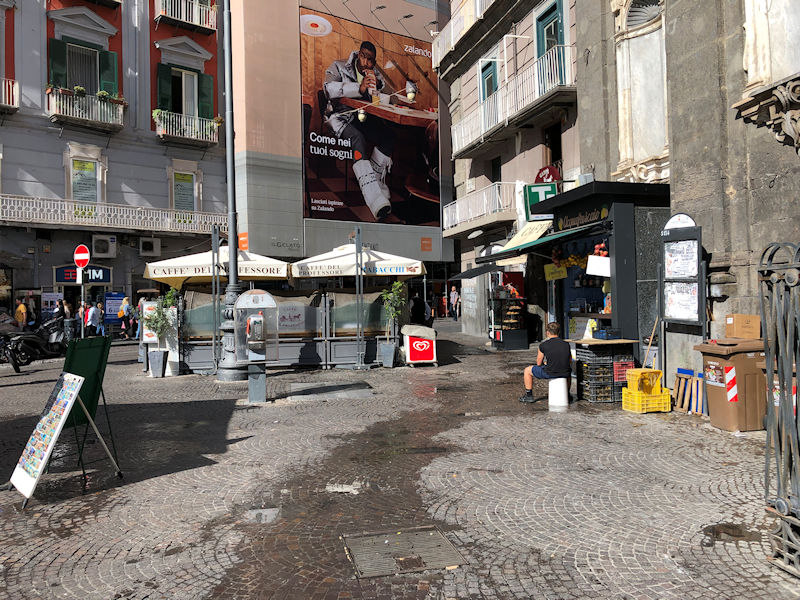
The Piazza Trieste e Trento at the start of the famous Via Toledo.
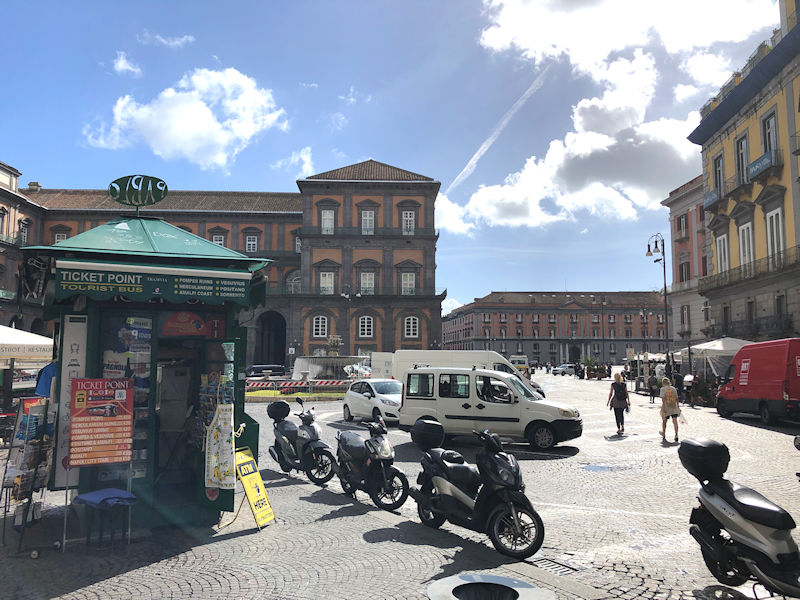
Facing directly across the piazza is the side of the Palazzo Reale di Napoli, or Royal Palace, this part housing a small museum of the San Carlo Theatre. Through the gap, we notice the vast Piazza del Plebiscito but intend to veer off into the wilderness of semi-claustrophobic streets on our right.
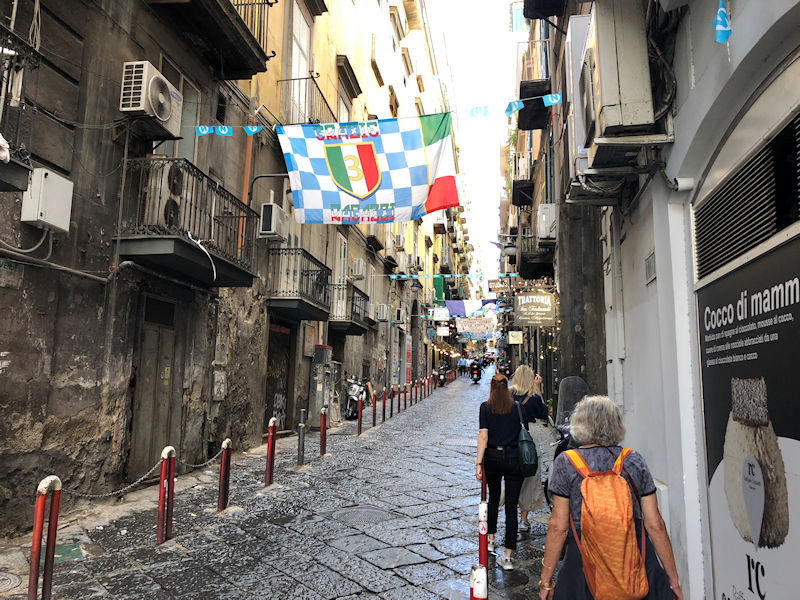
Bypassing the Via Toledo for the moment, we walking up the Via Nardones into the Chiaia neighborhood, bound loosely on several errands but most particularly seeking out a proper shoe repair shop for well-made Italian shoes.
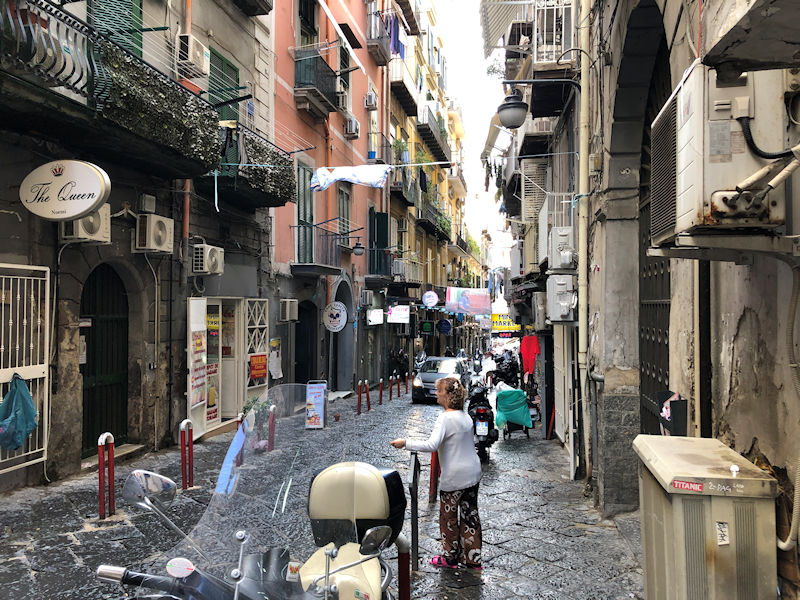
Still on Via Nardones. We've been given to understand that there are few old-school shoe-repair specialists around anymore, as in recent years nearly all Neapolitans have been opting for inexpensive footwear made in China and scarcely worth repairing.
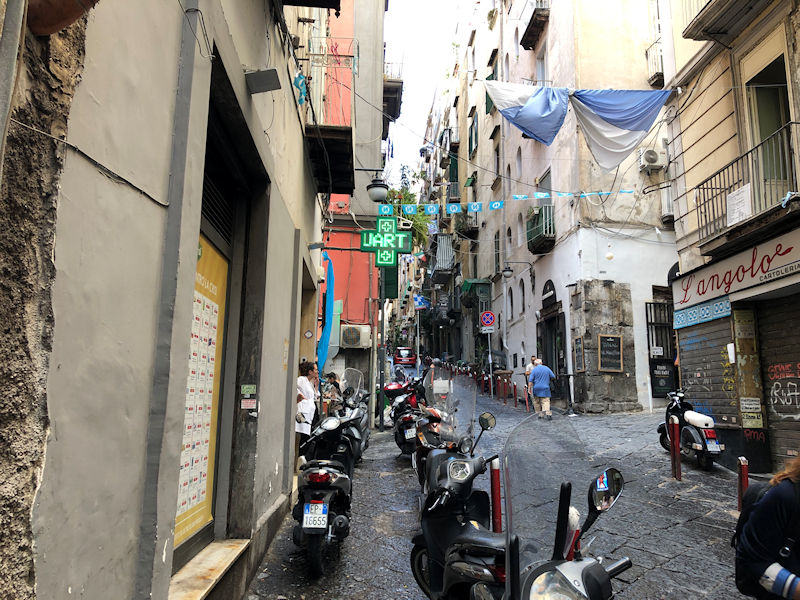
We're getting lost in the maze now.

And now we've wandered off our expectations after a while, and are presently entering the Spanish Quarter -- we'll come back later; we once stayed for a week in a converted convent in the Quartieri Spagnoli and would like to find the place to reminiscence about.

Now we've wandered down past the Gradoni di Chiaia itself in the Chiaia Quarter.

Here's the Piazza del Plebiscito, useful for community functions.

The two equestrian statues in front of the columned porch are of Carlo III on the left and Ferdinando I on the right, both probably complimentary, but the monumental building in the centre is just another Franciscan church (we'll come back to take a look-in later).
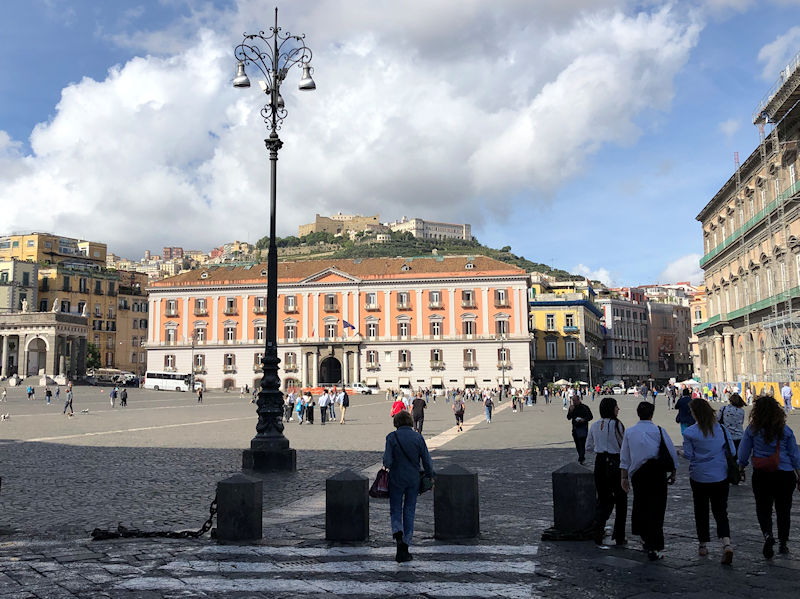
On the hilltop, overlooking the piazza, in fact the whole city, is the Castel Sant'Elmo fortress, and in front of it on the right, the Certosa e Museo di San Martino, the former Charterhouse or Carthusian monastery inaugurated by Queen Joanna I in 1368 and dedicated to the 4th century St Martin of Tours. Confiscated by the state in 1866, it now houses the National Museum of San Martino. We'll visit St Elmo in a few days.
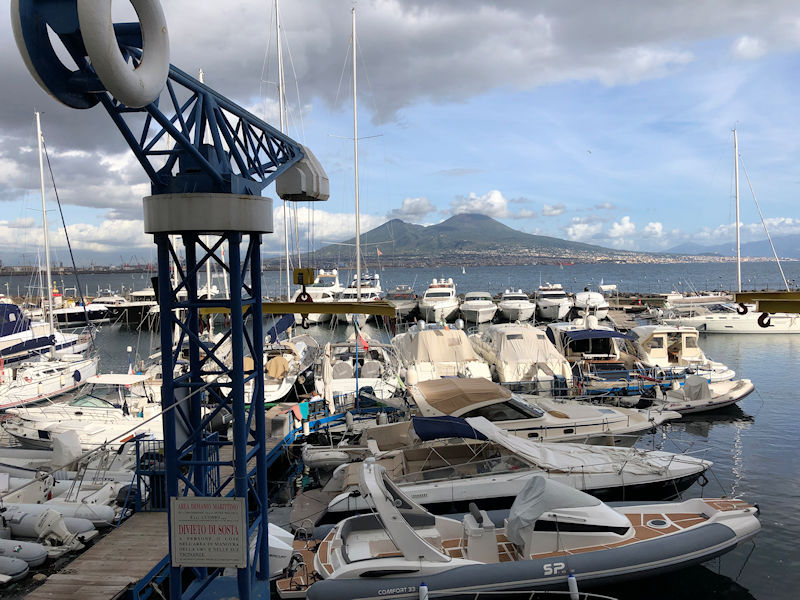
Mt Vesuvius without its hats on
Next up: The Museo di Capodimonte


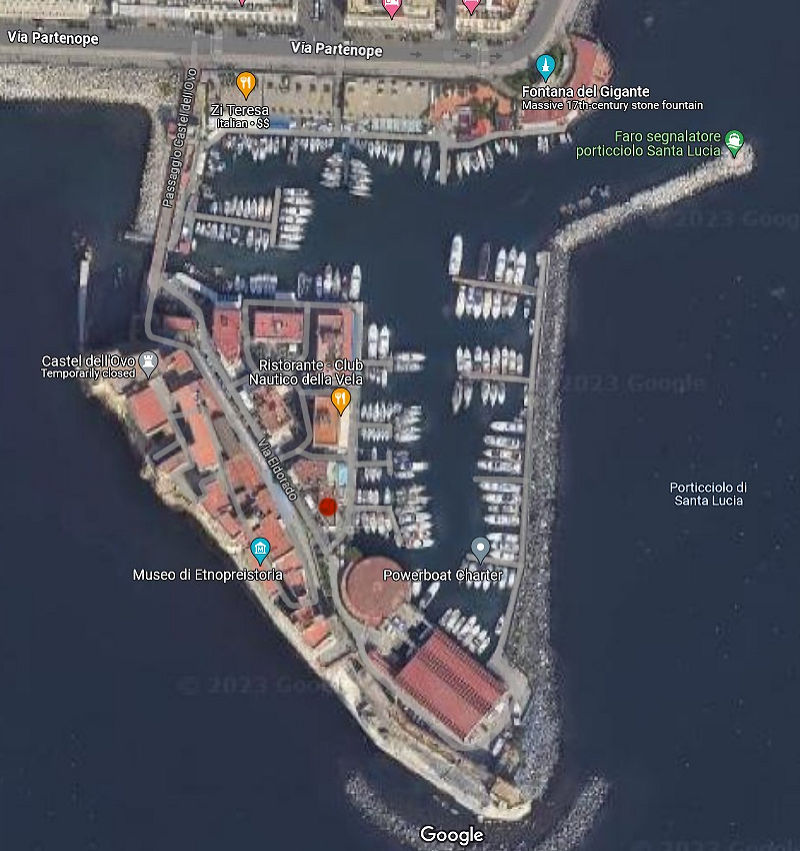
Castel dell'Ovo (red dot is us, we're waving) [courtesy of Google Maps]
 Dwight Peck's personal website
Dwight Peck's personal website
























































































